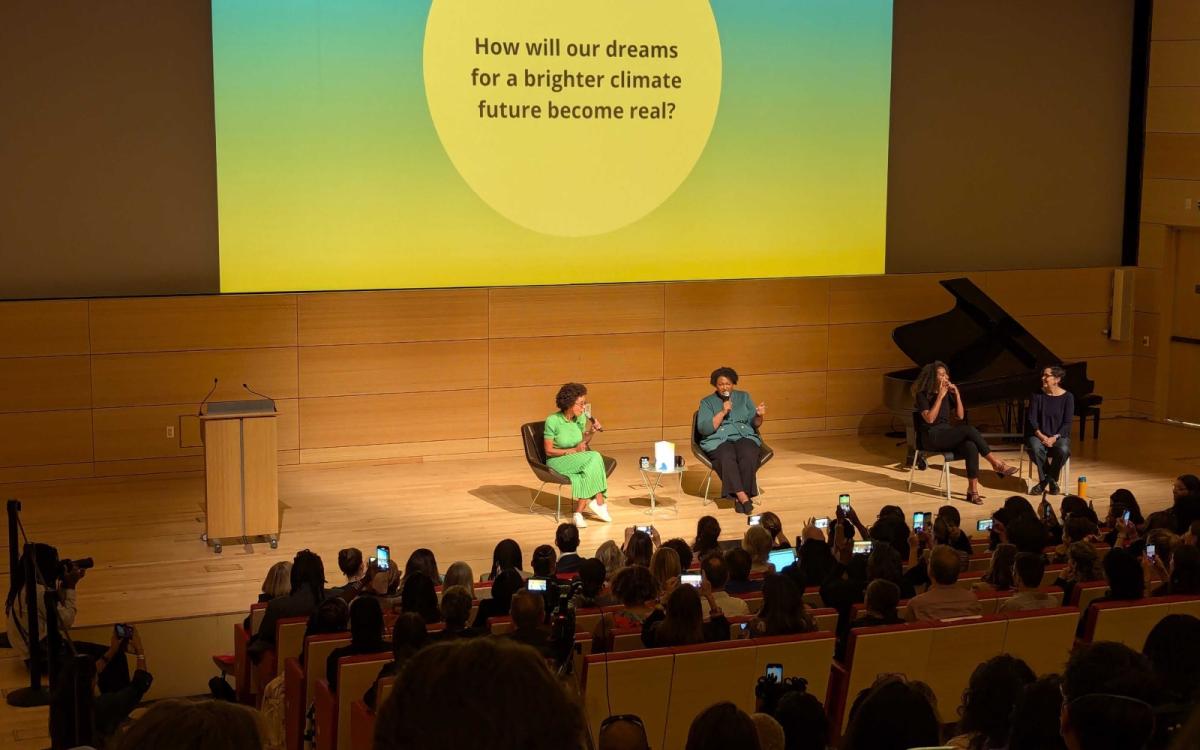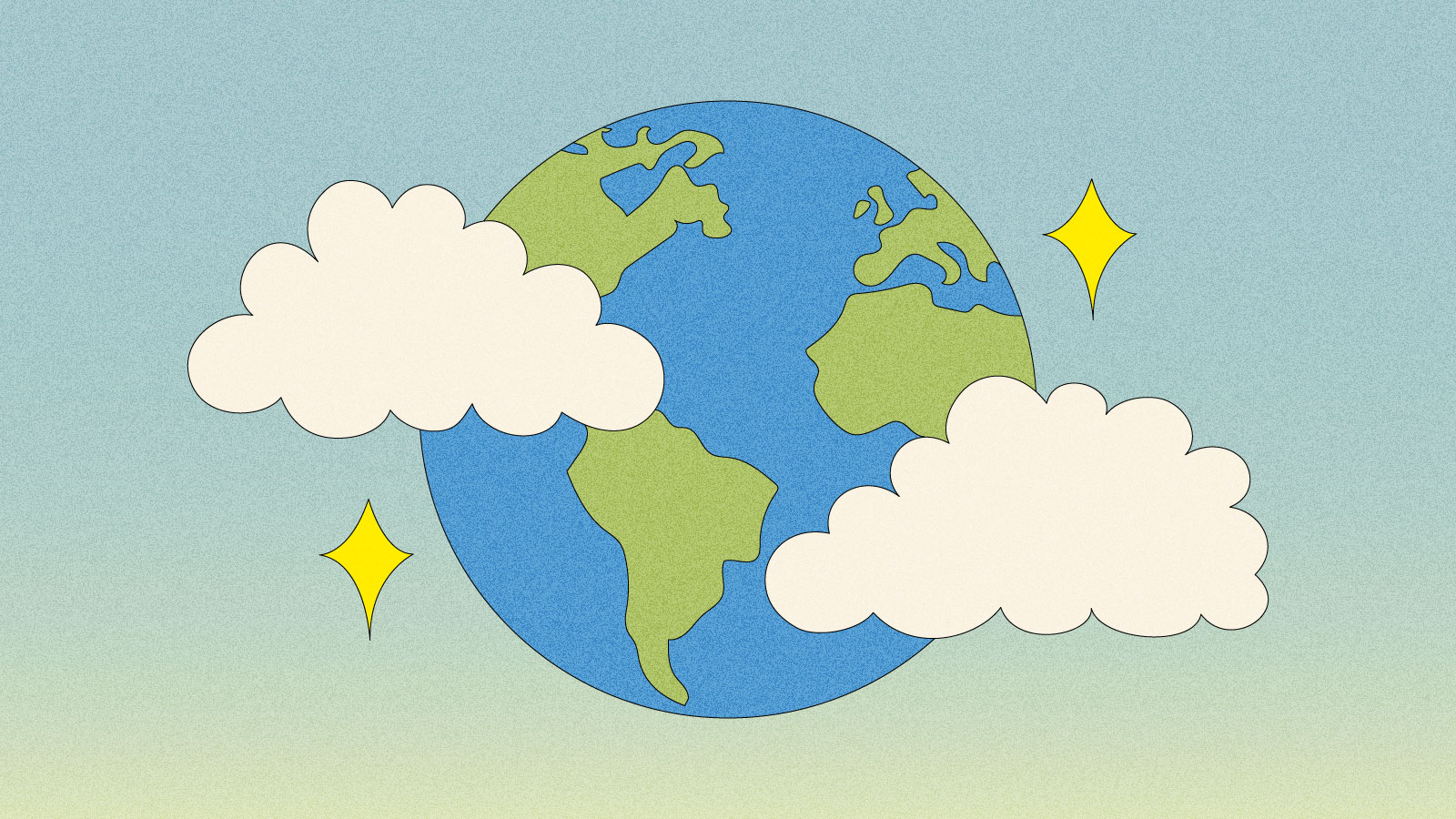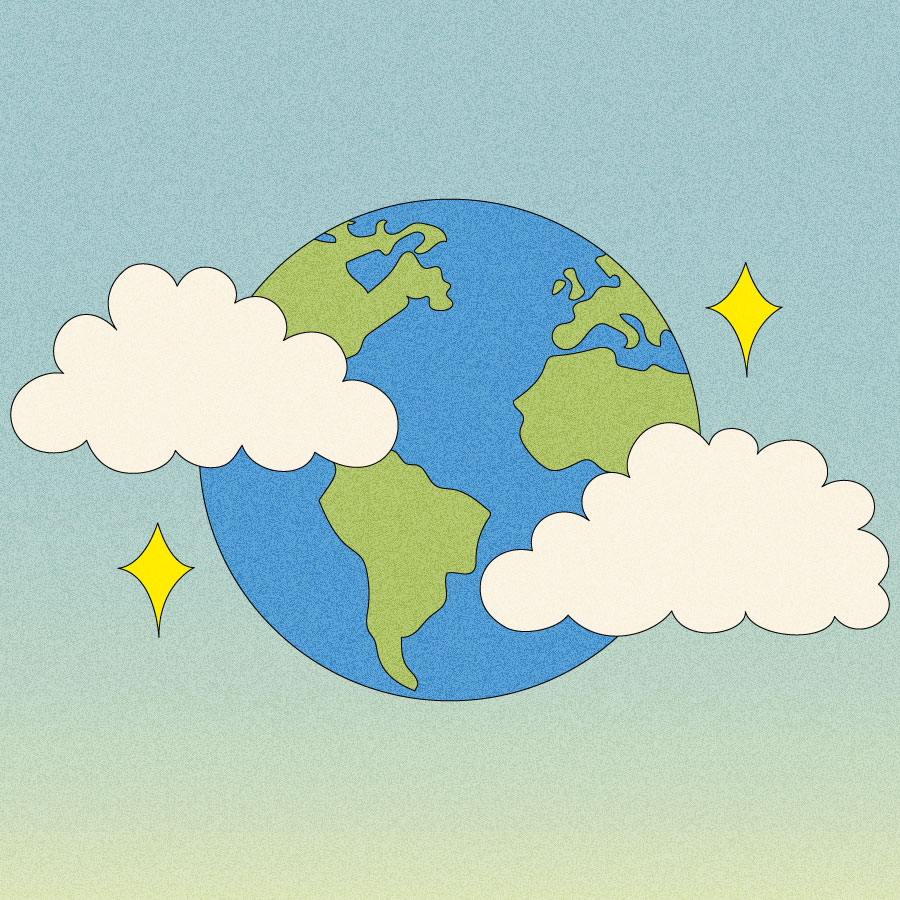The spotlight
If we get it right, the pace of life is more humane. Time that had been spent dealing with health- and flood-insurance paperwork, advocating for renewable energy, being stuck in traffic, and otherwise butting up against outdated and broken systems, is now used to grow food, prepare for extreme weather events, and care for each other. All streets, not just those in wealthier areas, are lined with trees (including fruit and nut trees), providing shade and beauty and photosynthesis (and snacks). Rain gardens and bioswales line streets, ready to absorb and divert storm waters. We linger outside, in parks and on sidewalks, with friends and neighbors. We have time to make meals at home or consume them at a cafe. “To-go” is uncommon; instead, we meet eyes as we chew. We know plastic recycling is mostly bullshit and have abandoned disposables — instead we (gasp!) wash the dishes. No longer frenzied with meaningless to-dos, we find ease amid the generational work of making our planet livable. As we spend more time outside, our appreciation for nature grows with immersion, inspiring ever more creative adaptations to our changed climate. Biophilia and biomimicry flourish in a virtuous cycle with the thriving of biodiversity. We are unrushed — chill, even.
— a DOUBLE drabble, thieved from the final chapter of
What If We Get It Right? By Ayana Elizabeth Johnson
The spotlight
Occasionally, when I’m reading an evocative book or article or other piece of literature, I’ll catch myself staring out the window, having looked up from the page involuntarily to daydream. Sure, it could be a sign of a short attention span (thanks, TikTok), but as a writer myself, I actually consider this to be one of the greatest effects a piece of writing can have. Because it’s not that my mind has wandered to unrelated topics — it’s that whatever I’m reading has inspired me in some way that sent my brain off to pause, process, and dream.
This happened to me repeatedly with What If We Get It Right?, a new book by marine biologist and climate policy expert Ayana Elizabeth Johnson (in conversation with a couple dozen other leading voices across the climate spectrum, including Bill McKibben, Rhiana Gunn-Wright, Adam McKay, and Leah Penniman). The book focuses on solutions, as well as visions of the world we could have if we implement them — and the importance of holding up those visions as something to work toward.
“These pages conjure a thriving (and quite different) world, and show us that it’s worth the effort — the overhaul — to get there, together,” Johnson writes in the book’s introduction.
On Monday, I got to hear Johnson share some of her insights on the book, climate solutions, our political moment, and hope, at a Climate Week event put on by Grist, Mother Jones, Rewiring America, and the Tishman Environment & Design Center at the New School.
The event was all about envisioning a better future. First, multidisciplinary artist Aisha Shillingford led us through a visioning exercise in which we traveled to the year 2075, witnessed an era dubbed “the Flourissance,” and returned with an artifact. (If you want to try a little visioning yourself, you might remember that Shillingford walked us through a similar exercise last year. You can do this at home!)
Then Johnson sat down in conversation with voting rights activist and former Georgia state Representative Stacey Abrams, who is now senior counsel at the electrification nonprofit Rewiring America, among many other things.

You may not be able to tell in this photo, but at this moment, Johnson and Abrams had, in fact, burst into a spontaneous singalong — to Prince’s “7,” the first track on the “Anti-Apocalypse Mixtape” that Johnson includes at the end of the book. Claire Elise Thompson
During the conversation, the two leaders discussed some of their practical visions for what we must do next to fix the climate crisis. They talked about the proliferation of climate tech, like heat pumps, and the wonderful synergies of when solutions that are good for the planet also make people’s lives better. And they confessed that they share a dislike for hope as a concept (something that Johnson makes clear in the book). “We don’t get to give up on life on Earth. I don’t need hope — I need an action item,” Johnson said.
Rather than hope or optimism, they spoke about holding up tenacity and determination as the mindsets we need to address the climate crisis. “My shorthand is, I think the glass is half full. It’s probably poisoned, though,” Abrams said, and described herself as “an ameliorist” — one who’s dedicated to making things better.
Before the event, Johnson and I spoke briefly about her approach to writing What If We Get It Right?, the power of manifesting, and some of the action items that are next on her horizon, including an exciting, and extremely unconventional, book tour. Our conversation has been edited and condensed for clarity.
(Also. Just as we were parting ways after our interview, as she was getting ready to head onstage for the event, Johnson called after me, “Claire! I love your drabbles!” One of the best moments of my professional life, period.)
Q. I really strongly resonated with something you wrote in the book’s introduction: “I created this book because it’s what I’ve needed to read.” Could you talk a bit about that need that you felt, and the gap that this book fills?
A. There’s a lot of apocalyptic stuff out there in pop culture — whether that’s out of Hollywood or the way the news just covers climate disasters, if at all. And I just kept thinking, we have the solutions we need. We just need to implement them. Why is no one showing us that it’s worth the effort? And so that’s what this book is: me making the case that it’s worth the effort to get this as right as possible, even knowing it won’t be a perfect world. It’ll be a better world.
Q. Why do you think it’s important to imagine the future? Not just forecast, but actually dream of the future?
A. I’ve been asked this question a lot of times — something different is coming to mind right now, which is, that’s just the way I do things. No one was like, “You should do a climate variety show in four different cities with all the famous acquaintances you can wrangle and a dance-off and puppets and magic tricks and game shows.” No one was like, “This is what a book tour should be.” But like, why not?
Creating this book and envisioning the tour has just been another exercise in, there’s really not as many rules as we think there are. You just do the thing. You dream the thing up, and then you do the thing. And we could do the same with climate that we could do with creating a book or piece of art — we could just create the future that we want to live in, create the world that we want to live in.
People use the term a lot, “manifesting,” right? Or “words become things,” or all of that. It starts somewhere. You dream it up and then, as much as you can, make it real in the world. There’s a sense in which my whole life is a case study in that. Because there’s no reason why some Black girl from Brooklyn should actually become a marine biologist because she said it out loud when she was 5 — a lot of people say that out loud when they’re 5. But there’s something about the tenacity of it. I’ve always been enamored with this sense of possibility. But in a sort of boring, realistic way. I wasn’t good with my imagination, per se — I wanted an imaginary friend and I couldn’t quite muster it. You know, I’ve always been very, very grounded in the real world. And I think maybe that’s helpful. My dreams are just big enough to be achievable. So I think it’s only natural that I apply that to climate. Like, why would we not try to do the biggest best thing we possibly can?
The sort of more standard answer, the one that I give in the book, is if the future is just a blank slate or a void, we aren’t moving as quickly toward it as we should. We’re sort of sauntering away from the apocalypse instead of running toward something. And we have these very vague notions of what the future could be, with solar panels and electric cars. But it’s not concrete enough for people. And I don’t know that this book meets the promise of the title, but it’s enough breadcrumbs that you can piece together a path. That’s the hope anyway, that it makes these visions of climate futures feel a little more concrete and feasible.
Q. That reminds me of a question you pose in many of your interviews with other leaders throughout the book — which is basically, “What’s the least sexy, most esoteric thing we need to do to make this happen?” But then at the end, you describe “implementation” as the sexiest word in the English language. Am I picking up that maybe all the wonkiest implementation things are actually the most exciting to you?
A. I mean, transmission lines, right? Or heat pumps! Like, I get Rewiring America‘s determination to make heat pumps sexy and I’m on board with this. I had supermodel Cameron Russell walking the stage at my book launch wearing that [heat pump] costume, just saying climate solutions, in high heels, full makeup. So I’m in for trying to make these things sexy, but it’s got to sort of be a bit tongue-in-cheek.
Q. Do you want to tell me more about the tour, and how that all came together?
A. The tour got sort of out of hand. It is 20 cities, six weeks, something like 40 events. I mean, if the goal is to welcome people in, you gotta go to a bunch of places where people are. But also, the tour was designed to visit the people featured in the book. There are 20 interviews in this book, there are a few co-authored chapters, there’s poetry, there’s art. I wanted to do the book tour to the places where these people live, so I could be in conversation with them as opposed to having it be the Ayana show. It’s like the Ayana and friends extravaganza. Every single tour stop is different.
I am an introvert, and this is sort of my nightmare. So I was like, the only way I’m going to do a book tour at all is if it’s fun. It doesn’t have to be miserable. It doesn’t have to be boring. It’s a great excuse to get to travel to all the people that I love. It’s also a chance to introduce all my favorite people to each other.
Q. I did also want to talk a bit about all the voices who contributed to the book itself. Did you always envision it with that format, with all the different interviews and contributors?
A. No. I was envisioning: I read a hundred books and then I pull elements from all these other experts and distill and paraphrase and present it back. But I was like, God, I don’t want to do that project, let alone read that book. And so I guess, in my own Climate Venn Diagram way, I was like, “Well, that doesn’t bring me joy. We’re going to have to find another way to do this.”

A worksheet version of the Climate Venn Diagram, an exercise Johnson invented for finding the sweet spot of what you love to do, what you’re good at doing, and what the climate movement needs. You can download this and do it yourself! Ayana Elizabeth Johnson
But my editor actually, Chris Jackson, has come for years to this event series I do at Pioneer Works called Science & Society. I always interview two people with complimentary areas of expertise — an ocean fisherman and an ocean farmer talking about the future of seafood, or a nonprofit leader and a scientist talking about the plastic problem, or the head of Wikipedia and of the Brooklyn Public Library talking about the future of public knowledge. And it has been shocking to me that, like, you can get 300 people out in Red Hook Brooklyn on a Tuesday night to listen to this stuff. There is an appetite for it. And my editor came up to me after one of them — he was like, “This is the book.” [Editor’s note: Shoutout to editors!] I was like, “What are you talking about?” And he said, “The thing that you do that is special is tell us who to listen to and then help us understand what the heck they’re saying.”
And so I thought the interview format would maybe be more lighthearted and literally conversational, and have that ease. Especially because these are people I’ve known for years, if not a decade, and I have a certain rapport with them and we can make fun of each other, and I can make them explain things, and I know enough about their work to make sure they’re not underselling or skipping part of it. My job was really to be a guide for the reader. And then the bonus is the audiobook is all their voices.
Q. What are some of your next chapters, now that this book is out in the world?
A. Well, the tour is a very big chapter. How do we avoid the tree-that-falls-in-the-forest — you don’t spend two years making a book and then just hope, in this crazy media landscape, that it finds all the right hearts and minds and hands. It has to be very deliberate.
For the Venn diagram, we have made these note cards of it that we’re giving out and making people fill out at every stop, to actually have people think together in a room about what that could be — and then hopefully talk about it after and see who else is interested in similar things. I’m bringing the Environmental Voter Project and Lead Locally on tour with me to make this very much into a get-out-the-vote initiative for environmentalists. Because 8 million registered voters with “environment” as their number one issue did not vote in the 2020 election — so it would be absolutely irresponsible of me to do a book tour in September and October of 2024 and not be focused on that.
My dream is to be a behind-the-scenes person in 2025 and beyond. We’ll see if I can pull that off, because people want a face to associate with the ideas — but I don’t have any interest in being that face. I don’t want to host a TV show or anything like that. I love the wonky policy memo stuff and I’m excited to devote more time to building up the work there.
I just launched a Substack newsletter, and embedded within that will be a What If We Get It Right podcast. A bunch of the conversations I’m having on this tour need a home. So I hired an audio producer to work with me on that — that launch is next week.
I’ve had this dream children’s book series in my head for like five, 10 years. So that may happen. But I just want to disappear into the woods of Maine, basically. This book is sort of my offering — I hope this is enough breadcrumbs that people can sort of follow one of the paths or chart their own, and then I won’t be needed.
— Claire Elise Thompson
More exposure
A parting shot
Johnson’s book also includes a few visuals of what a compelling climate future might look like, created by artist Olalekan Jeyifous. The photomontages conjure up a “protopian, sustainable community in ’90s Brooklyn — a future that is, as Olalekan puts it, ‘decolonized, decarbonized, draped up, and dripped out.’” As you can see in the image below, the green and joy-filled societies that Jeyifous imagined would call themselves the Proto-Farm Communities of Upstate New York, or PFCs.



